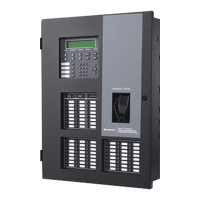LS10143-001SK-E Programming
9-14
SWITCH
(cont.)
P.A.S. ACK Positive acknowledge switch. This switch must be used in zones
programmed as Positive Alarm Sequence (see 9.3.1.2 ).
If an acknowledge switch closes when an alarm or trouble condition is
not already in progress, a trouble will occur.
You must use a UL listed normally open, momentary switch type. The
switch must be rated at 5V, 100 mA (minimum) and be used with an
EOL resistor for supervision.
ZONE AUX1 Latching Use these switch types if you want to monitor special zone-level
conditions (such as dry contact from a remote power supply).
Non Latching
ZONE AUX2 Latching
Non Latching
SYSTEM AUX1 Latching Use these switch types if you want to monitor special system-wide
conditions (such as dry contact from a remote power supply).
Non Latching
SYSTEM AUX2 Latching
Non Latching
DETECTOR Used to monitor conventional 4-wire detectors, a contact closure will
generate a detector alarm event.
FIRE TAMPER Latching Performs identically to a supervisory switch, but will be indicated as a
tamper switch on the LCD annunciator.
Non Latching
MANUAL
RELEASE
Manual release switch
INTERLOCK Interlock release switch input.
STATUS POINT
ECS INPUT Latching User also has ECS Event Number 1-8 option for ECS INPUT.
Only available when an ECS-VCM or ECS-NVCM is installed in the
system.
Non Latching
ECS TAMPER Latching
Non Latching
ECS SUPER-
VISORY
Latching
Non Latching
CO DETECT
SWITCH
CO Detector Switch
CO
SUPERVISORY
DETECT SWITCH
Latching CO Supervisory Detector Switch
Non Latching
NOTIF
OUTPUT PT Select Group Output point, a general use notification type. Use for driving standard
notification appliances.
AUX CONST Use constant power for applications that require a constant auxiliary
power source. Power is always present at constant circuits.
AUX RESET Use for auxiliary power, resettable applications. See Section 4.15.5.3
for a description of how this option operates.
AUX DOOR Use for auxiliary power, door holder applications. For example, if you
were using an auxiliary power supply for door holders, you would use
this option. See Section 4.15.5.1 for a description of how this option
operates.
Table 9-5: Programming Options for 6815 Modules
Type
Selection
Function Latching Option Comments

